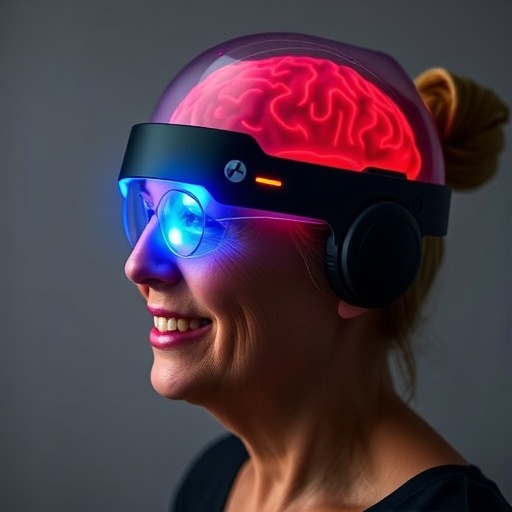A groundbreaking pilot study from researchers in the United Kingdom introduces an innovative, noninvasive technology capable of detecting early brain changes associated with Alzheimer’s disease, potentially revolutionizing the diagnosis and monitoring of dementia. This approach leverages broadband near-infrared spectroscopy (bNIRS), a compact and portable system that offers metabolic and hemodynamic insights beyond what conventional imaging techniques provide. As the burden of dementia grows globally, advances such as this could transform clinical practice by enabling accessible, repeated assessments outside traditional hospital settings.
Traditional neuroimaging modalities like Magnetic Resonance Imaging (MRI) and Positron Emission Tomography (PET) scans have been central to understanding Alzheimer’s disease, providing detailed structural and functional brain data. However, these methods remain costly, often inaccessible for routine or longitudinal use, and require complex infrastructure. In contrast, bNIRS measures dynamic changes in brain tissue by monitoring variations in light absorption, offering a noninvasive window to cerebral physiology with significantly less expense and greater portability.
What sets this new study apart is the use of broadband near-infrared spectroscopy that extends beyond tracking oxygenated and deoxygenated hemoglobin concentrations in the brain. By incorporating measures of the oxidation state of cytochrome c oxidase (oxCCO), a crucial mitochondrial enzyme tied to cellular energy metabolism, researchers gain access to a metabolic biomarker intimately linked to neuronal health. Cytochrome c oxidase participates in the electron transport chain within mitochondria, and its oxidation state reflects mitochondrial function, which is known to be compromised early in Alzheimer’s pathology.
The investigative team conducted a controlled pilot involving three distinct cohorts of elderly participants: cognitively healthy controls, individuals with mild cognitive impairment (MCI), and those diagnosed with early-stage Alzheimer’s dementia. Employing a simple visual stimulus—a checkerboard pattern—the researchers elicited measurable cerebral responses primarily from the visual cortex. The recorded signals included traditional hemodynamic parameters alongside oxCCO activity, captured synchronously using the wearable bNIRS system.
This study’s methodology showcases the nuances of brain response profiles in dementia. Key characteristics such as response amplitude and temporal delays displayed marked differences across the three groups. These findings underscore the potential of bNIRS not only to detect altered brain oxygenation but also to reveal metabolic deficits characteristic of neurodegeneration. Importantly, statistical models correlating these optical measurements with participants’ cognitive test scores underscored the critical role of oxCCO metrics. When oxCCO data were excluded, the predictive relationship between brain signals and cognition substantially weakened, highlighting the added diagnostic value of mitochondrial metabolic monitoring.
Mitochondrial dysfunction has long been implicated in Alzheimer’s disease, and cytochrome c oxidase oxidation state offers a direct, functional readout of this pathology at the cellular level. By advancing bNIRS technology to capture these signals noninvasively during functional tasks, the researchers have bridged a gap between molecular neuropathology and bedside diagnostics, all within a compact, wearable framework. This paradigm shift suggests that continuous monitoring of brain metabolism could become feasible even outside clinical environments.
The wearable nature of this technology means it can be deployed in patients’ homes or care facilities, democratizing access to brain health monitoring and providing clinicians with a valuable longitudinal dataset to assess disease progression or therapeutic response. Current imaging techniques rarely allow for such frequent and flexible usage, making bNIRS an attractive complement, especially for elderly populations that may find travel and hospital visits burdensome.
While the study’s sample size is limited, the robustness of its findings lays the groundwork for larger-scale trials. Future research will be needed to validate the reproducibility of bNIRS metrics and to refine analytical models that integrate metabolic and hemodynamic information for enhanced diagnostic accuracy. Moreover, the adaptability of broadband spectroscopy could facilitate the exploration of other neurological disorders characterized by mitochondrial dysfunction.
The prospects for integrating bNIRS with other neurophysiological and biochemical markers also open new avenues for comprehensive dementia profiling. By combining metabolic imaging with cognitive assessments, fluid biomarkers, and genetic risk factors, clinicians may soon adopt a multimodal framework capable of personalized diagnostic and therapeutic strategies, improving patient outcomes.
In summary, this pilot study heralds a new era in dementia diagnostics by demonstrating the feasibility and utility of broadband near-infrared spectroscopy for measuring brain metabolism and oxygenation noninvasively. The incorporation of mitochondrial biomarkers such as oxCCO within a wearable device underscores the potential for early detection and ongoing monitoring of Alzheimer’s disease in a more accessible, patient-friendly manner. Such technological innovation is poised to profoundly impact clinical neuroscience and pave the way for broader implementation of precision medicine in neurodegenerative conditions.
For those interested in exploring the detailed findings, the full study entitled “Mapping functional hemodynamic and metabolic responses to dementia: a broadband spectroscopy pilot study” is published in the Journal of Biomedical Optics. This seminal work exemplifies the integration of optical physics, neuroscience, and clinical innovation, providing a promising perspective on future diagnostics in brain health.
Subject of Research: Noninvasive neuromonitoring technology for early detection and monitoring of Alzheimer’s disease using broadband near-infrared spectroscopy.
Article Title: Mapping functional hemodynamic and metabolic responses to dementia: a broadband spectroscopy pilot study
News Publication Date: 3-Sep-2025
References:
Acharya, D., et al. (2025). Mapping functional hemodynamic and metabolic responses to dementia: a broadband spectroscopy pilot study. Journal of Biomedical Optics, 30(S2), S23909. https://doi.org/10.1117/1.JBO.30.S2.S23910
Image Credits:
Image courtesy of D. Acharya et al. (University of Cambridge).
Keywords
Neuroscience, Dementia, Cognitive disorders, Diagnostic imaging, Optics




